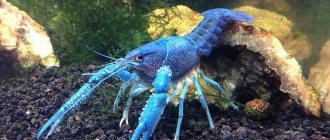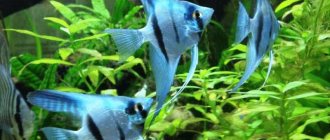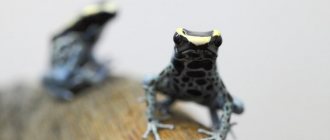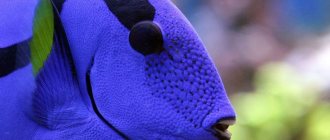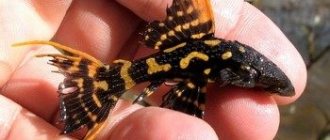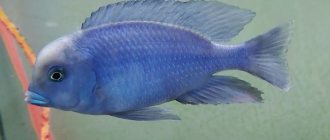Share this article:
This invertebrate animal is native to Australian shallow standing water bodies in the states of Victoria, New South Wales, and South Australia. The destroyer yabby is a beautiful bright blue freshwater arthropod, one of the representatives of the family of parastacid crayfish, which has recently become popular among aquarists. Its extraordinary appearance, habits, life in the home pond and the peculiarities of keeping and breeding will be discussed here.
What does he look like?
The body of the yabby (Latin Cherax destructor, English Blue Yabby) can be divided into three components: cephalothorax, abdomen, tail.
Cephalothorax . Legs and claws are attached to it for moving along the bottom. The jaws, mouth opening, eyes, antennae are located here, and all the vital organs are located inside.
Abdomen. Swimming legs are attached to it.
Tail . It consists of plates arranged in a fan, otherwise called the caudal fin, which provides accelerated movement of the invertebrate, and also creates a protective curtain of bottom sand when the crayfish escapes from the enemy.
The crayfish uses its jaws to deliver captured food to the mouth; it uses its claws to dig holes, move various objects in a pond, and fight with its enemies. Thanks to the active plowing of the soil with claws, Yabby bears the mark of Destructor (destroyer).
However, this representative of parastacid crayfish digs not for fun, but because in his homeland there was a direct need for this - this is how the animal, burrowing into moist soil, waited out the dry season.
The deeper the yabbie burrowed, the more likely it was to survive the drought.
A durable shell made of natural chitin serves the animal’s body as reliable protection from mechanical damage. And everything would be fine, but the yabby undergoes cyclical molting, when the previous shell becomes unsuitable for further wear, and it needs to be replaced with a more spacious and outwardly more attractive one. During this process, Cherax Destructor Yabby becomes vulnerable, as its soft body without a shell is an easy prey for anyone who wants to feast on it.
Yabby color variation vulcano.
Molting and regeneration
To ensure safety, the Australian destructor yabby hides in a secret place during the molting period, in order to appear before the underwater community later in all its renewed, durable glory.
If, for example, a crayfish loses a leg or claw in battle, a new one of exactly the same size will grow back after 2-3 molts (the regeneration process helps).
However, if a young individual undergoes molting quite often, then as it grows older this phenomenon becomes increasingly rare, and therefore regeneration takes more and more time.
Blue Destructor can be not only the color of sky blue, but also brownish-gray, greenish, slightly bluish.
It all depends on its habitat. But it is the bright blue Yabbie monsters, which have shovel-shaped powerful claws and reach a length of 18-20 cm, that have gained popularity among owners of home ponds. The life expectancy of the Australian Destructor in aquarium captivity reaches 10 years.
Description
The red claw crayfish is a very beautiful animal. The main color is bright blue with yellowish speckles throughout the body. The junctions between segments may be marked with blue, orange, red or pink, and there are red stripes on either side of the abdomen. In soft water the color becomes darker (black or brown).
Males are distinguished by powerful claws; in mature individuals, a wide flat growth (claw) develops on the outer side of the claws. This growth serves as a distinguishing feature of this species among the Heraxes. It can be whitish or pink, but is usually colored cherry-red (in brightly colored individuals), which is why this species gets its name - Cherax quadricarinatus red claw. This growth does not appear in males immediately, but only after the onset of puberty. If the male is ready to mate, the color of the claw becomes more saturated and bright, in contrast to the normal everyday state of the animal.
The length of the crayfish is up to 20 cm, weight up to 500 g, females are smaller and more graceful.
Cherax Destructor Yabbie Lifestyle
The blue handsome man leads the life of a typical hermit-individualist: loneliness is sweet to him! To arrange his daily life, he selects a secluded place under a stone or other shelter, where he digs a shelter for himself, camouflaging it with pebbles, shells, creating additional relief. The crayfish goes out to hunt for prey at night.
Yabby is not a cowardly type. If a conflict situation arises between the inhabitants of a reservoir, this pet does not retreat, but, raising its powerful claws at the ready, goes on the attack.
In a battle with superior enemy forces, the destructor will not bring the situation to the point of absurdity: having found the right moment, it will slam its tail fin to create a muddy silt curtain and, under its cover, will disappear from the battlefield.
What does the cancer owe for its survival in this case - a banal instinct of self-preservation or does it show signs of a unique intelligence - decide for yourself.
In a home pond, the Yabbie destructor behaves similarly to being in its natural environment. No matter how much the owner of the aquarium tries to improve the tank by planting plants and arranging aquarium decor in a certain order, the crustacean pet will move everything in accordance with its wishes, and first uproot the plants and then eat them. Hence the advice: place floating plants in the pond; others simply cannot survive in the vicinity of the blue destructor.
Habitat
Red claw crayfish (Cherax Quadricarinatus) habitats
Natural habitats Australia and New Guinea.
Found on the banks of shallow rivers and small streams. But mainly Cherax Quadricarinatus prefers ponds, closed reservoirs for irrigation and canals with standing water.
Unlike many of its brethren, Cherax Red Claw is not a typical digger. He finds refuge in natural shelters: under stones and snags, under the rubble of dead wood, under overhanging slopes of the banks.
Diet
The Australian beauty's diet is simple:
- insect larvae;
- dead fish;
- decaying vegetation - everything that ends up at the bottom of a reservoir in its area of residence.
No wonder it is also called the arthropod aquarium orderly. However, this does not mean that the yabbie does not need special feeding. On the contrary, the destructor crayfish is voracious and in the home pond it is fed with a varied and high-calorie diet, both live food (bloodworms, tubifex, daphnia, brine shrimp) and other plant foods.
There are special tableted foods for crustaceans from well-known manufacturers. However, food in the form of tablets for bottom fish species is also suitable for Yabbie. The Blue Aussie happily eats small portions of chopped carrots or pumpkin; you just need to make sure that all the food is eaten.
It is desirable that the majority of the arthropods’ diet should consist of plant foods, because the fiber contained in it is necessary for crustaceans for healthy and high-quality molting. Protein food should become an infrequent delicacy, because it makes crayfish grow faster and, therefore, molt more often.
It would seem that what could be bad about rapid growth? The fact is that molting is a very complex process for the organism of crustaceans, requiring a large amount of nutrients. If it happens too often, the crayfish simply will not be able to properly prepare for it and will die.
Nutrition
Mainly vegetarians and aquatic plants will be eaten with great appetite. Therefore, it is better to equip the aquarium with large stones and driftwood. The only way to somehow green the aquarium is to try using the Thai fern (Microsorium pteropus).
Mixed diet. The vegetarian part of the diet consists of vegetables, dry food, always oak or beech leaves, almond leaves deserve special attention (besides the fact that for Cherax quadricarinatus red claw this dish is a delicacy, it is also a powerful natural antiseptic, without the use of which the animal’s immune system weakened and it becomes susceptible to various diseases). In this case, you need to use only leaves that are brownish-reddish in color. Gray leaves should not be used as they were collected green and may contain toxic substances. Before using fallen leaves, they must be dried for at least a week. You cannot take decayed leaves from reservoirs, as the likelihood of introducing parasites into the aquarium is maximum.
In addition to foliage, the diet needs to be supplemented with various vegetables, peas, frozen food, snails, worms and granulated fish food, which should include calcium and mineral supplements, you can feed it with special food for crayfish that contains all the necessary substances.
Contents of Australian Crayfish
Since the behavior of the handsome blue Yabbie in aquarium captivity is identical to natural behavior, he will prefer as design elements in a tank intended for him:
- stones of various sizes and shapes;
- all kinds of driftwood and other natural material;
- artificial shelters made from shards and fragments of ceramic products and other things.
Dried oak or almond leaves are highly desirable in a home pond. They can be placed at the bottom of the container. There they become overgrown with microflora, which is ideal food for Australian crustaceans and brings the aquarium environment closer to natural for these pets.
As for the Cherax Destructor Yabbie's home itself - the home pond, there are some features:
Volume . Yabbies live in pairs or groups and need a fairly spacious tank - at least 200-300 liters. This will create good conditions for them to develop and reproduce, but this is ideal. A 100-liter capacity for a pair of destructors is also quite acceptable if good aeration of the water in the reservoir is ensured. Moreover, the aquarium water should be constantly saturated with oxygen, especially in the hot summer, because a lack of oxygen is detrimental to yabbies.
Water temperature . This type of cancer prefers colder water, the optimal temperature range is +16-24°C. The yabby will be most comfortable at a temperature of 22°C. One should take into account the fact that high temperatures accelerate the metabolism in the animal’s body, and this, in turn, shortens its life.
Water hardness and pH value . Crayfish need calcium to maintain the strength of the chitinous covering of the body, so the hardness index should be 10 units. and higher. The best water acidity values for a blue pet are 7.0-7.5 pH.
Water change . Despite all the unpretentiousness of yabby crayfish, changing the water in the tank is, of course, necessary to maintain its quality and maintain cleanliness in the aquarium. In this particular case, this should be done a quarter of a week.
Aquarium
An aquarium with a volume of 150 liters or more is suitable for one couple.
These crayfish are quite hardy and, given suitable conditions, can live for a long time in captivity. Keep in aquariums with hard water and a thick layer of soil. Temperature 23 – 26 ° C, crayfish tolerate small temperature fluctuations well, but it is undesirable for the temperature to drop below 18 ° C.
Red claw crayfish (Cherax Quadricarinatus) in aquarium 2
In summer, they can easily tolerate heat up to 30 degrees, although it is necessary to monitor the level of oxygen dissolved in the water.
This species is not picky about the purity and hardness of the water in the aquarium - it can be in the dGH range from 5 to 20; pH - from 6.5 to 8.5.
Fish compatibility
Viviparous fish can live in the vicinity of destructor crustaceans from Australia:
- guppy;
- platies;
- mollies;
- swordtails and others.
Fish eggs will undoubtedly be eaten if found. But the livebearers themselves are of no interest to crayfish from a gastronomic point of view, just like their fry. Therefore, their safety is guaranteed.
Shrimp are also uninteresting as a food option for crayfish, so they are quite suitable for blue destructors as neighbors in a pond.
Reproduction
At a young age, male and female yabbies are poorly distinguishable, but as they grow older, differences in size begin to appear - the male has more powerful claws, and the female has a wider abdomen and caudal fin.
In addition, in a male crayfish, at the level of the last pair of walking legs, at their very base, you can notice a kind of growths in the form of spines, which serve as a reproductive organ. They can be detected by turning the male upside down.
To breed yabby crayfish, you can place a mixed-sex pair or a male with 2-3 females in an aquarium. Before mating, the male performs a kind of courtship ritual: he pursues the female he likes, trying to persuade her to the act of copulation. Finally, the female gives in and lies down on the bottom of the reservoir, and the suitor, holding her by the claws, fulfills his mission of continuing the crustacean family.
After 2-3 weeks, eggs appear on the female’s pleopods, which she presses to the abdomen with her tail. The expectant mother, burdened with eggs, hides away from prying eyes in a favorite shelter, where, like oars, her pleopods from time to time deliver a new portion of water to the eggs in order to provide the offspring with oxygen.
Even getting food for the female during this period is not easy, since the future Cancer dad vigilantly watches her every step: as soon as she appears from her hiding place, he immediately persistently forces her to return.
